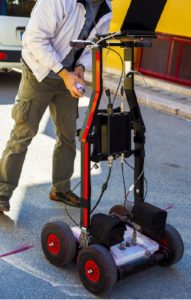
Ground-penetrating radar (GPR) is a wonderful technology that serves many uses during construction projects. It can gather data through concrete structures and even underground. Also, it can analyze the data it gathers. By using GPR, construction projects are made significantly safer for the people working on site. Today, we will go over everything you should know about ground penetrating radar.
The Basics
Ground-penetrating radar does exactly what the name may suggest; it penetrates the ground’s surface and tries to detect obstructions beneath the surface. It does this by sending high-frequency radio signals deep underground. Those signals then get bounced back to the receiver. The data gathered underground gets recorded using a computer, which then determines how long it took for the signal to go underground and back to the surface. The time it took the pulse to return to the receiver lets workers know how deeply the signal traveled and where it went towards the obstruction.
Data Collection Underground
Many types of ground-penetrating radar are needed to locate underground targets. The type that’s needed will depend on how deeply the target is buried, as well as the target’s size. After the target is found, GPR signals can get sent to it. These signals will bounce off the target roughly one thousand times every second. After the data gets returned via the signals, the data can either be analyzed at that moment, or the user can save the data to be analyzed later.
Data Collection Through Concrete
Different GPR will be needed for different targets. By scanning these targets, people can determine how thick the concrete is and where the objects are underneath the concrete. A type of map forms that allows people to locate obstructions. Then, by using virtual slices of the image that gets created, a second map can be formed. This second map is 3D and more thorough than the original image.
Data Analysis
Data analysis can be impacted by various factors, including the material through which the signals have to travel. You will likely want to hire professional help interpreting the data because, with their experience, they are less likely to misinterpret the data, and accurate interpretations are a must.
Concrete Visions Will Get The Job Done Right
Concrete Visions has been working with clients for over 25 years. Our G&M Services installers are certified with the industry’s major firestop product manufacturers. As part of our firestop service, we can assess abnormal field conditions and, with the manufacturer’s technical support assistance, provide engineering judgments in a timely fashion to comply with contract specifications. Our Field Mechanics undergo ongoing training, including mandatory monthly safety meetings, weekly Toolbox Talks where safety and equipment information is shred, and trainings on safe work standards and safety best practices.
